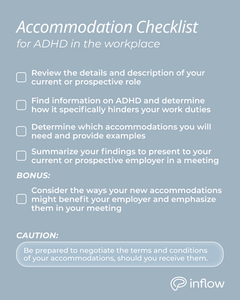The Americans with Disabilities Act (ADA) became law in the USA in 1990 and applies to businesses with over 15 employees. The ADA protects individuals against workplace discrimination and provides equal employment opportunities.
It covers disabilities1 that "substantially [limits] one or more major life [activities]." In addition, individuals must have a record of a disability and be regarded as having a disability.
What are “reasonable accommodations” for the workplace?
When folks think of reasonable accommodations, they may picture those implemented for physical disabilities, such as ramps, curb cuts, and elevators. However, the ADA lists examples that apply to cognitive disabilities (ADHD, aphasia, dyslexia, etc.), as well as physical disabilities.
Examples of reasonable accommodations for ADHD
Reasonable accommodations can include, but are not limited to:1
- Job restructuring
- Working from home
- Part-time or modified work schedules
- Adjustment or modification of equipment, devices, training materials, or company policies
- Uninterrupted work time
- A private or quiet workspace
- Use of noise cancellation or white noise (check out our blog on sensory processing to learn why you may benefit from this accommodation)
How do I know if I qualify for ADHD accommodations?
Under the ADA, "qualified" individuals must be able to perform the essential job functions of their position, with or without accommodations. Generally, this means fulfilling the listed duties in a written job description.
So, when reading job descriptions, be sure to review the entire text carefully. If you have concerns about some elements of a job wherein you may need accommodations, you may consider highlighting them in the interview process. For current workers that believe they may need accommodations, my advice remains the same: read your job description and highlight areas where you may need one or more of the accommodations above.
How do I know if I need ADHD accommodations?
This is a personal question that requires a bit of self-reflection. While many adults with ADHD perform at their jobs with little conflict or issues, not all of us live the same experience. Adults with ADHD often struggle with procrastination, distractions, communication skills, and project management. Some that grapple with these issues may find their own methods and hacks to handle them.
We’ve talked about using timers or similar methods before (1, 2); while such techniques are fantastic for getting you unstuck, they are very different from actual accommodations. If these tips and tricks don't help, you might consider requesting formal accommodations that are upheld by law.
How to request ADHD accommodations at work
I won’t lie — asking for accommodations can feel scary! Whether you're newly diagnosed or burnt out - or both - supervisors may feel like you're asking for too much too soon. But if you are lucky enough to have access to a diagnosis and have documentation, you are within your rights to ask.
Here are a few tips to help you prepare for the conversation with your employer:
1. Share details about your ADHD with your employer.
Find basic information on ADHD and write down how it impacts your work responsibilities specifically. Share these details with a boss/manager in a private meeting.
2. Know your duties.
Print out your job description or read it side-by-side with a word processor. Then, for every duty you need help with, highlight or copy it down and provide a reason for each accommodation.
3. Use examples.
When appropriate, provide examples of accommodations that would help with an issue. For instance, say you work in a busy office. You might ask for noise-canceling headphones to assist with drowning out office chatter. Depending on your job, you might elevate that to work-from-home status.
4. Explain how your accommodations will benefit your employer.
When asking for accommodations, be sure to include how it could help the company. Explain that your accommodations will only help you be more productive and efficient. Some employers may respond better when the “what’s in it for me” is crystal clear.
Moving forward
You reviewed the official description of your position, researched possible accommodations, and wrote it all down. Now it's time to move forward and start the conversation with your employer. You'll need to share the information you've gathered on ADHD accommodations and listen to their thoughts on what they find reasonable.
⚠️ Heads up! Prepare yourself for possible negotiation. The tone and outcome of the discussion may differ depending on the job and employer. Keep your notes close and stick to what matters to you.
Resources
Not sure where to start? Need some extra help brainstorming? The three links below can help you get started on your Accommodation Journey.
Wait! - before you leave to hyperfocus on this! Save our ADHD Accommodation Checklist to your device for an easy way to remember important tasks and track your progress on your Accommodation Journey. Good luck!!

1. Accommodation and Compliance: AD/HD from the Job Accommodation Network (AskJAN)
2. ADHD in the Workplace from the Society for Human Resource Management (SHRM)








